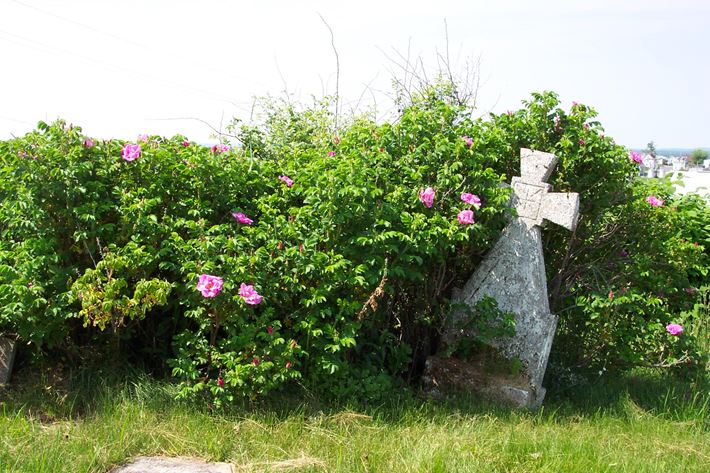Gravespotting: Old Calvary Cemetery, Whitney Pier
By Scott Sharplin
Despite what idioms may tell you, ignorance is not usually bliss. However, there is an undeniable delight to starting a cemetery snoop with no prior knowledge whatsoever. My gravespotting method is as follows: pick a cemetery at random, explore as much of its treasures as my four-year-old sidekick’s attention span allows, and then – only then – learn what I can about the history of the site.
This willful unpreparedness paid off in spades with Old Calvary, a small spread of very old plots clinging to the top of the hill where Church Street meets the Lingan Road. I’d driven past this spot a hundred times, and it had always seemed more expansive than it is – a trick of the topography, as driving south one comes upon the cemetery suddenly, round a bend in the road. This impactful reveal combines with the hill’s steepness, which prevents a driver from seeing where the cemetery ends.
In truth, I estimate Old Calvary has only about 100 to 200 graves. This seemed woefully inadequate for a cemetery serving Whitney Pier, but until I got home to my computer, I wouldn’t know the reason for such a small plot. I would have speculated that there was a “New Calvary” someplace nearby (I would have been wrong), except I even missed the cemetery’s name, carved on a low, grave-like marker. Ignorance is bliss, but it’s also befuddlement.
If I’d had to invent a name on the spot, it would have been half right: “Old” is the only Christian name for a place like this. A great many of the tombstones are cracked or decapitated, with fallen crosses lying fallow for so many years, the earth has begun to reclaim the stone. Other severed heads are propped up against their splintered bases, bearing fading jigsaw epitaphs. It seems like a majority of stones have birthdates from the 19th century, and I caught a few 1890 death dates, too. As a prairie boy, I marvel at the fact that there were vast populations of Canadians who never dipped a toe into the twentieth century. Ignorance is a narrow historical perspective.
As I meandered, I proposed different names to myself: Old Avalanche? Old Crumblebump? None of them conveyed the brokedown majesty of the place; but it would certainly have to be something suggesting a lack of balance. Not only is the cemetery on a generally steep hill, but erosion has turned it into a topographic wonderland, with strange swells and divots seeming to swallow or disgorge the lichen-carpet stones. Some markers seem situated on plateaus, or perhaps balconies, from whence the upright royal markers look down sneering on the tottering, careening masses. Meanwhile, fractured graves hide in grassy bowls, ashamed to show their heads.
The most eerie and delightful side effect of the geographic tumult is a broad patch of churned-up earth that resembles nothing so much as a huge flat face. Even the four-year-old could see it – though we agreed not to discuss the fact that its position, in the centre of the cemetery, made all the thin bent headstones seem like giant fingernails scrabbling out from the earth. Instead, I let the kid keep on believing they were great big chess pieces, playing out a particularly brutal match.
Along the cemetery’s lower perimeter, a sprawling rose bush has taken charge, obscuring several markers and half-smothering others. Were it not for the garish presence of the Whitney Pier Rink just beyond, the roses are a hauntingly romantic sight; for maximum gothic atmosphere, crouch down among the nearby markers, and use the low angle to block out the rest of the world while humming something by the Cure.
Or don’t! The rest of the world is worth a look-see, too. In fact, Old Calvary permits a splendid panorama of the Pier, plus loads of standard-issue Cape Breton gorgeousness beyond that. The Pier’s joyful diversity of church spires is on display, although the red brick tower of Holy Redeemer is achingly unblocked by St. Mary’s Polish Church, whose loss (by fire in 2014) is still great cause for mourning. Beyond, the harbour gleams blue and the Highlands gloam purple. One could scarcely pick a finer spot from which to launch a bold exploration of the island.
At home, I learned that this was exactly such a spot for two of the Pier’s most courageous populations. According to findagrave.com, Old Calvary is “also known as the Holy Redeemer and St Mary's Polish Cemeteries since Holy Redeemer owns the cemeteries and shares them with St Marys.” This fact explains the profusion of headstones bearing Italian or Polish names and inscriptions. The site goes on to say that “New Calvary Cemetery is located up the hill, corner of Brooks Street and Gatracre St.” This helps to explain Old Calvary’s disrepair, as well as my weird impression that the graveyard was a lot bigger.
I checked with Google Maps, and sure enough: the whole time I was exploring Old Calvary, another Calvary was less than two blocks distant. Ignorance may be bliss, but knowledge is an excellent reason to return.
Scott Sharplin is a freelance writer and theatre artist and an instructor at Cape Breton University. After growing up in Edmonton and studying playwriting in Montreal, Scott settled in Cape Breton to do the wife-house-car-dog-child thing. He is both active in, and a huge fan of, the Cape Breton theatre community. He also enjoys role-playing games, and even writes them professionally now and then. He lives in Sydney.












0
Log In or Sign Up to add a comment.- 1
arrow-eseek-eNo items to display